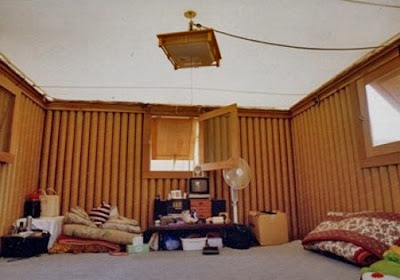 Japanese architect Shigeru Ban designs emergency shelters made of paper tubing for more than 2 million people. Those people became homeless after the civil war in Rwanda 1994. The office of the United Nations High Commissioner for Refugees (UNHCR)
normally supplied plastic sheets and aluminium poles to be rigged as
temporary shelters. But refugees
started to sell the aluminium poles and then proceed to cut down trees to
use branches for structural support.
Japanese architect Shigeru Ban designs emergency shelters made of paper tubing for more than 2 million people. Those people became homeless after the civil war in Rwanda 1994. The office of the United Nations High Commissioner for Refugees (UNHCR)
normally supplied plastic sheets and aluminium poles to be rigged as
temporary shelters. But refugees
started to sell the aluminium poles and then proceed to cut down trees to
use branches for structural support. Because of the deforestation it
was obvious that alternative materials had to be found. Shigeru Ban had
found a low-cost alternative, paper tubes and the development of
shelters began.
Because of the deforestation it
was obvious that alternative materials had to be found. Shigeru Ban had
found a low-cost alternative, paper tubes and the development of
shelters began.
With the development of these shelters the cost of transportations are reduced. Because manufacturation of paper tubes are cheap and simple on-site. In 1998, fifty emergency shelters were constructed in Rwanda. In this way Shigeru Ban saved thousands of people's lives with bringing safe and cheap solution.
 His first shelter design was started in 1995 in Kobe, Japan. After a huge disaster, he decided to
build a place for victims who survived the Kobe earthquake. There was only one
solution to satisfy the needs of Kobe earthquake victims, which also would keep
them alive and healthy: the Paper Log Houses. The main
idea of Paper Log Houses aroused from the issues mentioned above; to give
shelter for the people and a temporary “home” where they could feel safe and
warm.
His first shelter design was started in 1995 in Kobe, Japan. After a huge disaster, he decided to
build a place for victims who survived the Kobe earthquake. There was only one
solution to satisfy the needs of Kobe earthquake victims, which also would keep
them alive and healthy: the Paper Log Houses. The main
idea of Paper Log Houses aroused from the issues mentioned above; to give
shelter for the people and a temporary “home” where they could feel safe and
warm.
The architect aimed to solve the necessity requirements of the victims
and at the same time by using recycled materials aimed to serve the environment
and its protection. Efficiency
both in terms of time, cost and design shared equal importance. In order to achieve this efficiency during
the formation of Log houses materials had to be chosen carefully. The materials to be used to construct the
paper houses should have been cheap, easy to build and eco-friendly.
Most
of the material he used came from trash in his every project. Some were donated by firms and some were
collected. Such as; he used sand-filled
beer cases for the foundation of the houses and paper tubes for the walls. For the insulation, an adhesive waterproof sponge tape is sandwiched between the tubes. The units are easy to dismantle and the materials are appropriate for recyling. One shelter costs less than 2000$.
We
can say that with Ban’s cheap and simple solution, people’s lives became more
or less normal after a disaster. His Paper Log Houses can be adapted and
applied easily by anyone. We learned that impact of creativity could play
positively important role in our lives if used wisely. In short, it is possible
to say that good designs and innovative ideas can solve many problems people
face as Shigeru Ban has clearly shown us.

